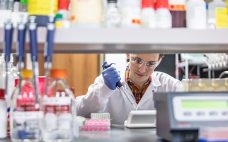When to Use Transfection Reagents, Viral Transduction or Electroporation No single delivery method is ideal for all situations, but researchers may routinely employ a suboptimal approach for the sake of familiarity or to avoid any start-up costs associated with new methods. In this white paper, we will describe three methods (chemical, electroporation and viral transduction) and highlight the Mirus Bio TransIT® and VirusGEN® transfection reagents and Ingenio® EZporator® Electroporation System, which are both easy to use and cost-effective. Additionally, we…
Author Archives: BPI Contributor
Virtual Demonstration of the BioSMB Multi-Column Chromatography Platform
This webinar provides a virtual demonstration of the BioSMB multi-column chromatography platform — a fully scalable single-use solution that reduces resin usage and enables manufacturers to explore continuous processing. The demo starts with an overview of the BioSMB PD system for small-scale manufacturing and then continues with the BioSMB Process systems for clinical and commercial manufacturing. Click here to watch this virtual demonstration.
Ask the Expert: High-Yield mRNA Processing — From Plasmid to Highly Purified Product
Interest in industrial-scale production of messenger RNA (mRNA) has surged amid rapid development of mRNA-based vaccines against SARS-CoV-2. During an 18 February 2021 Ask the Expert presentation, AleÅ¡ Å trancar (chief executive officer of BIA Separations, a Sartorius company) reminded attendees that no platform approach yet exists for mRNA production and that much remains to be learned about manufacturing such products at commercial scales. He described current production challenges and shared BIA’s efforts to devise flexible mRNA purification tools. Å trancar’s Presentation…
Ask the Expert: Leveraging Cloud Capabilities to Execute CHO Cell Culture Experiments
Process development teams have relied for decades on benchtop bioreactors to perform mammalian-cell–culture experiments; however, doing so requires significant resources and staffing. During a 24 February 2021 presentation, Deborah Pascoe, PhD, vice president of operations at Culture Biosciences (Culture), explained how to leverage her company’s high-throughput, cloud-connected bioreactors to execute Chinese hamster ovary (CHO) cell cultures with high reproducibility and scalability. Pascoe’s Presentation Pascoe described her company as an extension of a customer’s laboratory. After technology transfer, Culture and a…
Virus-Like Particle Production in Insect Cells Using the Baculovirus Expression System: Addressing Challenges across the Workflow
This webcast features: Maya Yovcheva, R&D Scientist, Cell Biology, Chantelle Gaskin, Field Applications Scientist, Purification, and Florian Durst, Sr. Field Application Specialist, Pharma Analytics, Thermo Fisher Scientific Being part of the newer generation of vaccines, virus-like particles (VLPs) have proven to be effective in humans as well as animals. VLPs mimic the structure of the virus particles they are derived from and are highly immunogenic, but they lack the virus genomic material which gives them a favorable safety profile. The…
CHO Cell Culture Media & Feeds
Media selection is a crucial step in optimizing and maximizing your upstream process. Our chemically defined catalog media portfolio offers a comprehensive range of off-the-shelf products to support all of your CHO production processes, including fed batch and perfusion mode. Learn more.
Manufacturing a Recombinant Retrovirus: Downstream Purification Process Development through GMP Implementation
This webcast features: Mark Fitchmun, President and CEO, Somatek, Inc. Purification of enveloped viruses and virus-like particles presents several challenges due to their large size and complexity. In this webinar, a case study will be presented and will detail the importance of resin screening, endonuclease treatment, process development, and the scale-up purification of a retrovirus-like particle intended for use in human subjects. The resulting current good manufacturing practice (CGMP) compatible process required approximately four hours to purify 240 L of…
Crude Sample Analysis in Process Development: Time and Cost Savings
This overview highlights a few examples from drug discovery and process development where the Octet® system demonstrated a significant reduction in the analysis time over ELISA and HPLC by eliminating the need for purification, while still achieving high accuracy and precision. The total assay times were dramatically reduced with fewer assay steps and less labor time involved. The easy and versatile, fully integrated Octet® assay has additional advantages over other label-free technologies like SPR, where sample washing steps are required.…
Increase Efficiency in Your Manufacturing With the Right Buffer Management Strategy
This webcast features: Jenny Dunker, Global Product Manager, and Alex Troken, Global Product Manager, Cytiva Buffer preparation is still a highly manual activity in the biopharmaceutical industry that often requires a lot of resources due to the large number and overall volume of buffers and process liquids used in a typical bioprocess workflow. Most companies are still relying on the traditional ways of preparing buffers, but there are more modern, alternative buffer preparation methods that can bring significant savings and…
Formulation and Characterization Strategies for Gene Therapies
This webcast features: Sarathi Vijay Boddapati, PhD, Associate Director, Formulation and Drug Product Development, Catalent Cell and Gene Therapy Formulation studies for gene therapy products are currently limited in scope and revolve around gathering stability data at frozen storage conditions. A systematic approach towards understanding degradation mechanisms followed by buffer and excipient selection is required. Catalent Cell & Gene Therapy is working towards an approach for gathering product knowledge and establishing formulation selection criteria using traditional/routine techniques that are historically…








